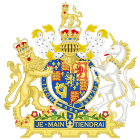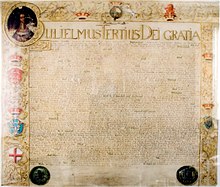
Back Act of Settlement 1701 Afrikaans قانون التسوية 1701 Arabic Акт аб пераходзе ў спадчыну прастола (Вялікабрытанія) Byelorussian Zákon o nástupnictví Czech Act of Settlement German Acta de Establecimiento Spanish لایحه حلوفصل ۱۷۰۱ Persian Yhdistyneen kuningaskunnan vallanperimyslaki Finnish Act of Settlement 1701 French Act of Settlement Frisian
| Act of Parliament | |
 | |
| Long title | An Act for the further Limitation of the Crown and better securing the Rights and Liberties of the Subject |
|---|---|
| Citation | 12 & 13 Will. 3. c. 2 |
| Territorial extent |
|
| Dates | |
| Royal assent | 12 June 1701[4] |
| Commencement | 6 February 1701 |
| Other legislation | |
| Amended by | Various
|
| Relates to | Bill of Rights 1689 |
Status: Amended | |
| Text of statute as originally enacted | |
| Revised text of statute as amended | |
The Act of Settlement is an Act of the Parliament of England that settled the succession to the English and Irish crowns to only Protestants, which passed in 1701.[b] More specifically, anyone who became a Roman Catholic, or who married one, became disqualified to inherit the throne. This had the effect of deposing the remaining descendants of Charles I, other than his Protestant granddaughter Anne, as the next Protestant in line to the throne was Sophia of Hanover. Born into the House of Wittelsbach, she was a granddaughter of James VI and I from his most junior surviving line,[c] with the crowns descending only to her non-Catholic heirs. Sophia died shortly before the death of Queen Anne, and Sophia's son succeeded to the throne as King George I, starting the Hanoverian dynasty in Britain.
The Act of Supremacy 1558 had confirmed the independence of the Church of England from Roman Catholicism under the English monarch. One of the principal factors which contributed to the Glorious Revolution was the perceived assaults made on the Church by King James II, a Roman Catholic, who was deposed in favour of his Protestant daughter Mary II and her husband William III. The need for this Act of Settlement was prompted by the inability of William and Mary, as well as of Mary's Protestant sister (the future Queen Anne), to produce any surviving children, and by the perceived threat posed by the pretensions to the throne by remaining Roman Catholic members of the House of Stuart.

The Act played a key role in the formation of the Kingdom of Great Britain as, though England and Scotland had shared a monarch since 1603, they had remained separately governed countries, with the Act catalysing the Union of England and Scotland. However, the Parliament of Scotland was more reluctant to abandon the House of Stuart, members of which had been Scottish monarchs long before they became English. Moreover, the Act also placed limits on both the role of foreigners in the British government and the power of the monarch with respect to the Parliament of England, though some of those provisions have been altered by subsequent legislation.
Along with the Bill of Rights 1689, the Act of Settlement remains today one of the main constitutional laws governing the succession not only to the throne of the United Kingdom, but to those of the other Commonwealth realms, whether by assumption or by patriation.[5] The Act of Settlement cannot be altered in any realm except by that realm's own parliament and, by convention, only with the consent of all the other realms, as it touches on the succession to the shared crown.[6] On 26 March 2015, following the Perth Agreement, legislation amending the Act came into effect across the Commonwealth realms that removed the disqualification arising from marriage to a Roman Catholic and instituted absolute primogeniture.
Cite error: There are <ref group=lower-alpha> tags or {{efn}} templates on this page, but the references will not show without a {{reflist|group=lower-alpha}} template or {{notelist}} template (see the help page).
- ^ Toffoli, Gary (9 February 2013), Is There a Canadian Law of Succession and Is There a Canadian Process of Amendment? (PDF), Canadian Royal Heritage Trust, pp. 3–4, archived from the original (PDF) on 27 November 2013, retrieved 12 February 2013
- ^ Macgregor Dawson, Robert (1970). The Government of Canada (5th ed.). Toronto: University of Toronto Press. p. 63. ISBN 9780802020468.
- ^ Anne Twomey (18 September 2014). Professor Anne Twomey – Succession to the Crown: foiled by Canada? (Digital video). London: University College London.
- ^ "House of Lords Journal Volume 16: 12 June 1701 | British History Online".
- ^ Toporoski, Richard (1998). "The Invisible Crown". Monarchy Canada (Summer 1998). Toronto: Monarchist League of Canada. Archived from the original on 9 February 2008. Retrieved 16 May 2009.
- ^ "The Statute of Westminster 1931", legislation.gov.uk, The National Archives, 1931 c. 4
© MMXXIII Rich X Search. We shall prevail. All rights reserved. Rich X Search